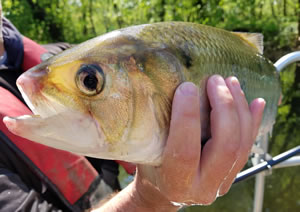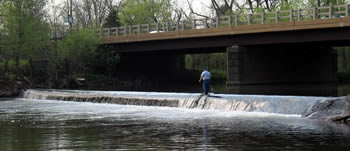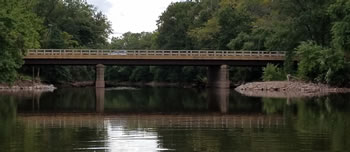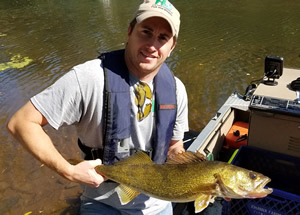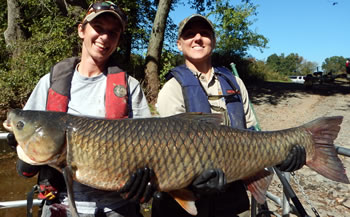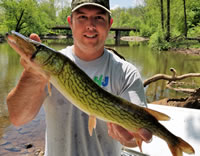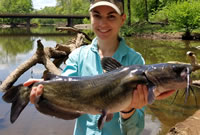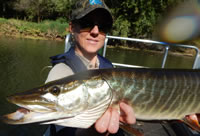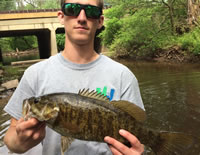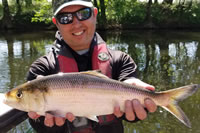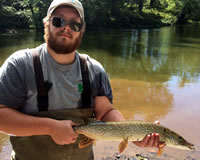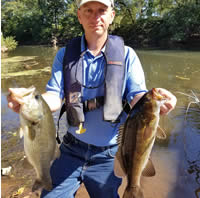by Shawn Crouse, Principal Fisheries Biologist
The 133-foot long and five-foot high dam was originally built to provide power at the Weston Mill. The site included a gristmill, sawmill, the dam, and associated waterpower features. The dam had no current purpose; the mill buildings were claimed by arson in July, 1983. In recent years, the dam had partially failed. It was removed in August of 2017 through a Natural Resource Damage Assessment settlement agreement reached between the Trustees for Natural Resources - the NJDEP, the U.S. Department of Interior's Fish and Wildlife Service, and the U.S. Department of Commerce's National Oceanic and Atmospheric Administration - and the party potentially responsible for contamination related to the American Cyanamid Superfund Site in Bridgewater Township.
The Division of Fish and Wildlife (with partial funding from the settlement agreement and assistance from the US Fish and Wildlife Service and the Watershed Institute(formerly Stonybrook-Millstone Watershed Association)) committed to monitor changes to the fish assemblages above and below the dam, before and after dam removal. Efforts will continue for the next several years. Electrofishing surveys are conducted during the spring and fall at five monitoring locations:
The 38-mile-long Millstone River, a tributary of the Raritan River, boasts a wide array of fish diversity with more than fifty species found in recent years. Migratory species, including American Shad, Gizzard Shad, Blueback Herring, Striped Bass, and American Eel, have been documented passing the Island Farm Weir fish ladder on the Raritan River near its confluence with the Millstone River, approximately 1.5 miles downstream of the former Weston Causeway Dam. They have also been documented in the Millstone River as part of this project. It was exciting to find adult American Shad during spring sampling and even more invigorating to document young-of-the-year fingerlings in the fall of 2016. Due to the fragile nature of these species, capture and handling are limited to minimize stress and possible mortality.
In the lower reaches, the most numerous species captured were American Eel, Common Carp, Redbreast Sunfish, Bluegills, and Spottail Shiner, with moderate numbers of Largemouth and Smallmouth Bass and Channel Catfish. The surveys near Blackwells Mills and Griggstown, where the river is noticeably smaller in every measurable way, yielded large numbers of American Eel, Redbreast Sunfish, Bluegill, and native forage species such as Spottail Shiner and Tessellated Darter. Less commonly known species such as the Comely Shiner and Shield Darter (potential for listing as a Species of Special Concern) are also found in the Millstone, along with the Bridle Shiner in its tributaries, a potential State Endangered Species. Other fishes of conservation interest, and more often found in the Pinelands, are found in the southern-most headwaters including the beautiful Bluespotted Sunfish, Mud Sunfish (potential Species of Special Concern), Swamp Darter, Tadpole Madtom, and the Pirate Perch.
Fishing access on the Millstone River is plentiful, particularly through the Delaware & Raritan Canal State Park. Most of the river is wadable or can be fished from its banks, but the best approach is drifting in a kayak, canoe or small jon boat. The river can be fished easily by boat from the primitive boat launch at the southern end of Lincoln Avenue Park, downstream of the Wilhousky Street/Weston Causeway bridge in Manville. Be sure to scope out the river in advance and plan your access and portage locations wisely as you will encounter a combination of shallow water, dams, and rapids that can endanger your outing. With improved fish passage and the river reverting back to a more natural flow regime, one might anticipate several responses in the fish assemblage. The most beneficial change would be opening additional stream mileage to migratory species such as American Shad, Blueback Herring, and Striped Bass. Additional game species such as Walleye and Musky may also move upstream, although so may several undesirable species. As habitat shifts from lake-like to a more stream-like habitat, species such as Smallmouth Bass might outnumber Largemouth Bass. There might also be changes in Species of Conservation Concern such as Comely Shiner and Shield Darter. These are all reasons why it is important to continue to monitor the dynamic fish populations of the Millstone River. There is no doubt that the "Mighty Millstone" is an underrated fishery, but don't just take my word for it - get out and see for yourself! For now, enjoy the array of photos taken on the Millstone over the last two years.
Thumbnails below link to larger images.
|
|||||||||||||||||||||
|
||
|
|
||
|
||
| |
||

